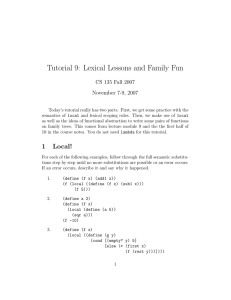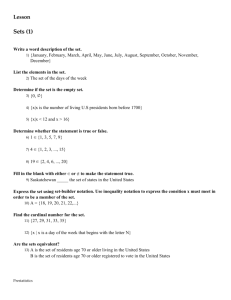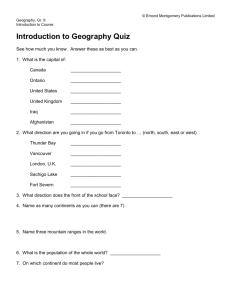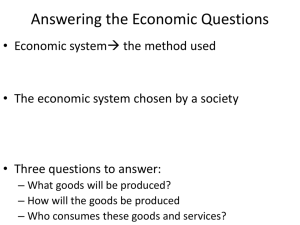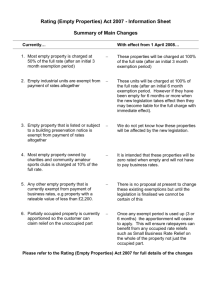Tutorial 7: Trees and Mutually Recursive Data CS 135 Fall 2007
advertisement
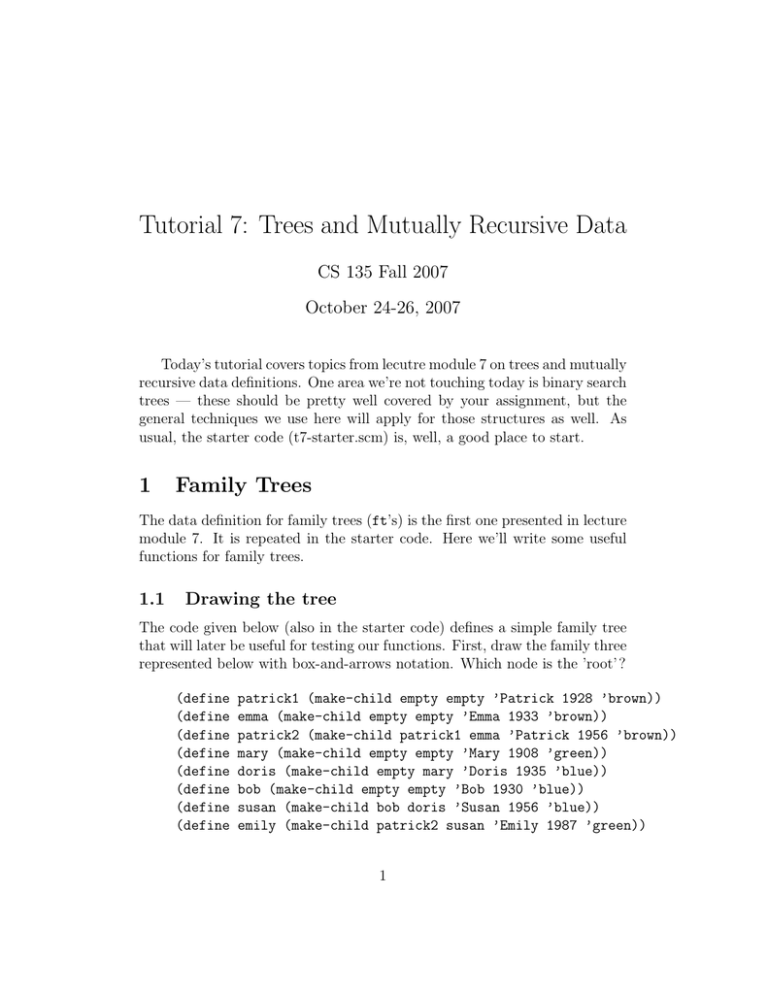
Tutorial 7: Trees and Mutually Recursive Data CS 135 Fall 2007 October 24-26, 2007 Today’s tutorial covers topics from lecutre module 7 on trees and mutually recursive data definitions. One area we’re not touching today is binary search trees — these should be pretty well covered by your assignment, but the general techniques we use here will apply for those structures as well. As usual, the starter code (t7-starter.scm) is, well, a good place to start. 1 Family Trees The data definition for family trees (ft’s) is the first one presented in lecture module 7. It is repeated in the starter code. Here we’ll write some useful functions for family trees. 1.1 Drawing the tree The code given below (also in the starter code) defines a simple family tree that will later be useful for testing our functions. First, draw the family three represented below with box-and-arrows notation. Which node is the ’root’ ? (define (define (define (define (define (define (define (define patrick1 (make-child empty empty ’Patrick 1928 ’brown)) emma (make-child empty empty ’Emma 1933 ’brown)) patrick2 (make-child patrick1 emma ’Patrick 1956 ’brown)) mary (make-child empty empty ’Mary 1908 ’green)) doris (make-child empty mary ’Doris 1935 ’blue)) bob (make-child empty empty ’Bob 1930 ’blue)) susan (make-child bob doris ’Susan 1956 ’blue)) emily (make-child patrick2 susan ’Emily 1987 ’green)) 1 1.2 Counting Write a function ancestors-named which consumes a family tree and a symbol for a name and produces the number of ancestors in the tree with the given name. 1.3 Mothers’ Names Write a function mother-names that produces a list of the names of everyone in a given family tree that is a mother (with duplicates). 1.4 We don’t mean radioactive... Some sociologists use the term ’nuclear family’ to refer to a family with some children and exactly two parents. For our purposes, we’ll say a family tree represents a nuclear family iff all children in the tree have exactly two or zero parents. Write a predicate function nuclear-family? which returns true iff the given ft represents a nuclear family. 1.5 Respect your elders! Note that each child structure contains a field for the year the child was born. Use this information to write a function oldest-ancestor which consumes an ft which is not empty and produces a child node corresponding to the oldest ancestor in the tree. If there is a tie, return any one of the oldest. 2 Food, Glorious Food This half of the tutorial will make use of a new mutually-recursive data definition, which is in the starter code and repeated here for convenience: An expression of type food is of the form (make-food nme veg ilst), where nme is a string for the name of the food, veg is a boolean (true iff the food is vegetarian), and ilst is an ingredients-list. An ingredients-list (or ’il’) is either empty or (cons rat (cons f ilst)), where rat is a number (for the ratio of that ingredient), f is a food, and ilst is an ingredients-list. 2 2.1 Template Write a template for a function that consumes an expression of type food. 2.2 Contains? Write a function contains-food?which consumes a string (for the name of a food) and a food, and returns true iff the given food contains an ingredient (or sub-ingredient etc.) with the given name. 2.3 Vegeterian check Notice that each food has a field which indicates whether it is vegetarian. But suppose we want to be really sure that a food contains no non-vegetarian products. To accomplish this, write a function veg-check? which consumes a food and produces true iff the food and all foods which it contains are all vegetarian. 2.4 Ingredient weight Write a function ingredient-weight which consumes a food, the total weight of that food, and the name of a single ingredient, and produces the weight of that ingredient in the original food. 2.5 Almost vegetarian If one per cent or less of a food is not vegetarian, then probably no one can tell. In this case, we’ll call the food ’almost vegetarian’. Write a function almost-veg? which consumes a food and produces true iff at least 99 per cent of that food is vegetarian. 3

